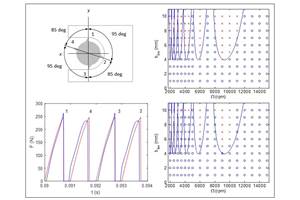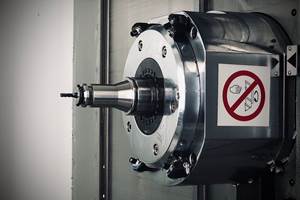Tooling Displays Now More Hands-On
Horn USA’s new booth concept is designed to enable attendees to (literally) get a better feel for its various tooling offerings.
Share






A new sintered chip breaking geometry for SuperMini boring tools helps solve one of the biggest challenges in internal machining: the generation of long chips that wrap around the tool. Source: Horn USA
Horn USA’s booth in the West Building has been redesigned for this show to enhance attendee experience. Traffic flow has been streamlined and product areas for static and rotating tools are more clearly defined to help attendees locate the tooling solutions for which they are searching.
And although you’ll find numerous display boards with tooling affixed to them, the company has created trolley systems to enable attendees to be more hands-on with select tooling solutions.
Where this concept is particularly helpful is in realizing the advantages of the company’s newest versions of its SuperMini line of tools. The trolleys in that area include microscopes attendees can use to get a better appreciation of the features of those exceptionally small tools. (It makes sense. Picture a tool that can bore a hole as small as 0.008" in diameter. Think you could see and appreciate the tool’s geometry with the naked eye? I’m guessing not.)
The SuperMini system launched in 1989 and includes tools for boring, profile turning, internal grooving, threading, chamfering, face grooving, drilling and slot broaching. So what’s new for the show? That’d be a sintered chip breaking geometry to help solve one of the biggest challenges in internal machining: the generation of long chips that wrap around the tool, clog holes or, in the worst case, lead to tool breakage.
This is where the new chip breaking geometry can help. It guides and shapes the chip, causing it to break. Previously, specially lasered or ground chip breaking geometries were used for this purpose which increased insert cost. With the Supermini type 105, Horn has succeeded in developing a universal boring tool with sintered chip breaking geometry offering high process reliability due to its good chip control, the company says. The cutting edge geometry extends far into the corner radius of the insert to help ensure chip control even with small infeed settings. The geometry can be used universally for different material groups and is suitable for internal, face, copy and back turning.
Product trolleys are also found in booth locations for technology partners W&F (modular, quick-change systems for static and driven tools on Swiss-type lathes), Urma (interchangeable-head reaming systems) and Farhion (precision collet toolholding systems). This offers a way to experience the quality of the tools by handling them, the company says, rather than if they were affixed to a display board. It also helps company application engineers better explain their features and benefits.
You’ll also see that video is a big part of Horn USA’s booth. Trolleys are fitted with interactive tablets running video and you likely won’t miss the 3' × 3' × 3' video cube in the middle of the booth or the 20' flat screen on the booth’s back wall. And, like in years past, the company will have technical team members available to review actual part prints with customers, discuss the challenges machining those parts and possibly provide a quote for tooling before returning home from the show. That’s a nice service.
Related Content
Orthopedic Event Discusses Manufacturing Strategies
At the seminar, representatives from multiple companies discussed strategies for making orthopedic devices accurately and efficiently.
Read MoreIndexable Drill Heads Double Profitability
Moving to a robust line of indexable drills enabled this shop to dramatically alter the manufacturing process for a problem part, doubling its profitability.
Read MoreThe Impact of Cutting Teeth Spacing on Machining Stability
Many cutter designs are available, and variable teeth spacing (or variable pitch) cutters can be used to influence milling stability. Let’s discuss why teeth spacing affects stability.
Read MoreHow to Troubleshoot Issues With Tool Life
Diagnosing when a tool is failing is important because it sets an expectation and a benchmark for improvements. Finding out why gives us a clue for how to fix it.
Read MoreRead Next
Machine Shop MBA
Making Chips and 91±¬ÁĎÍř are teaming up for a new podcast series called Machine Shop MBA—designed to help manufacturers measure their success against the industry’s best. Through the lens of the 91±¬ÁĎÍř benchmarking program, the series explores the KPIs that set high-performing shops apart, from machine utilization and first-pass yield to employee engagement and revenue per employee.
Read MoreAMRs Are Moving Into Manufacturing: 4 Considerations for Implementation
AMRs can provide a flexible, easy-to-use automation platform so long as manufacturers choose a suitable task and prepare their facilities.
Read More





















